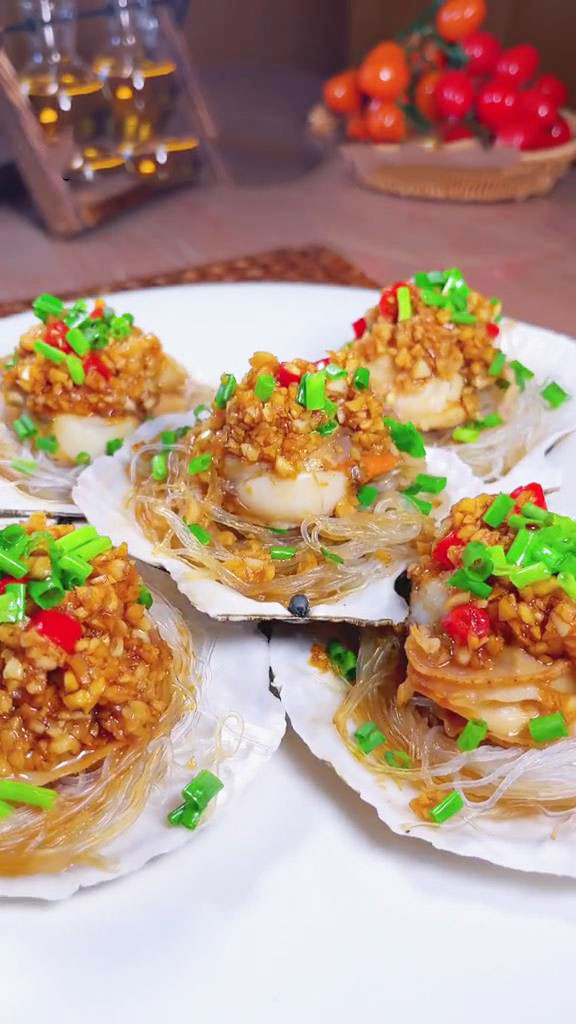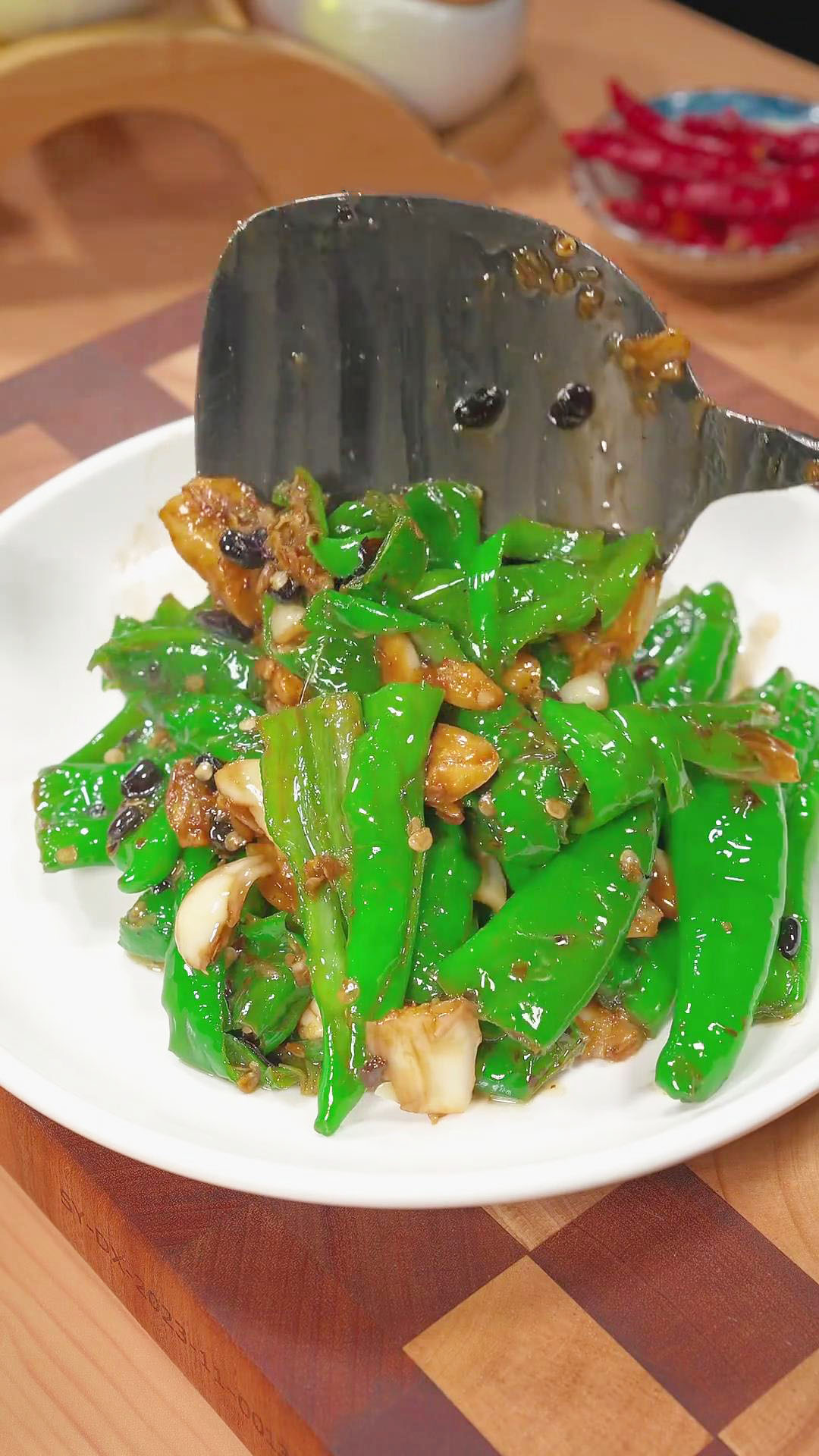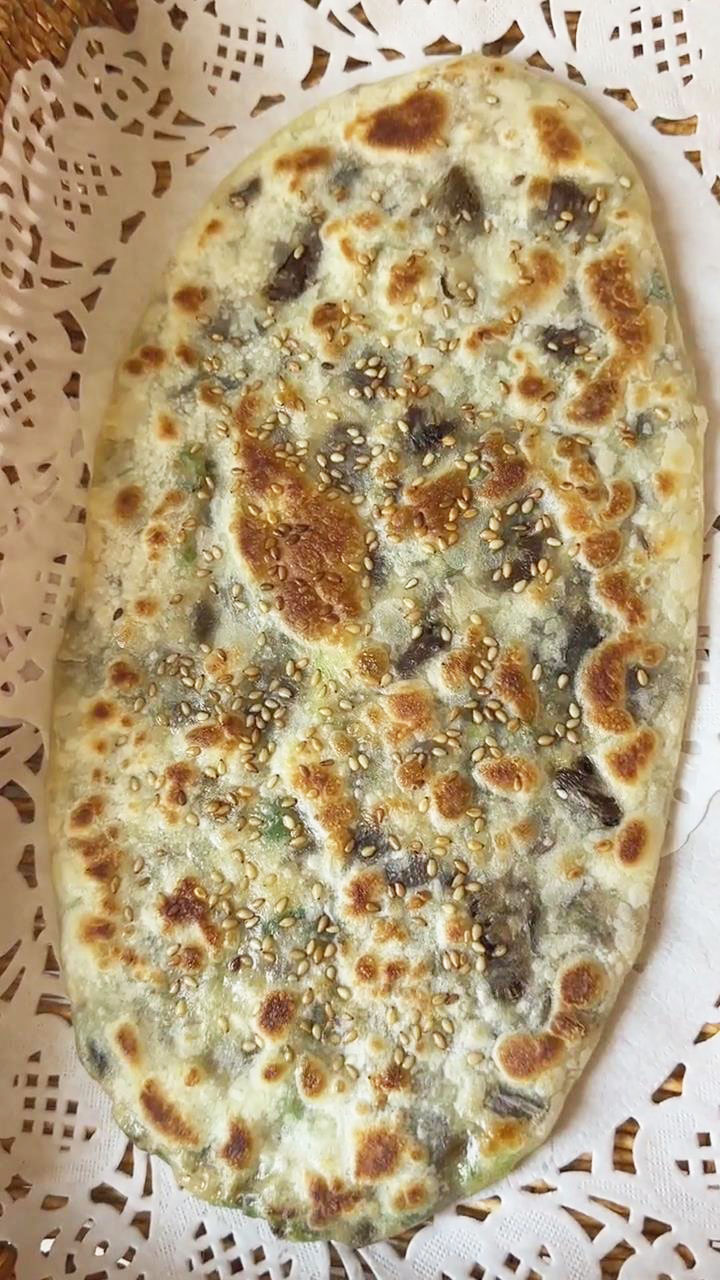This post may contain affiliate links. Please read our disclosure policy.
Looking for a different kind of bacon? Try this cured pork belly, a Chinese take on bacon that is marinated and air-dried for a week or more. You can make this using pork belly seasoned with salt, light soy sauce, Shaoxing wine, Chinese 13 Spices, and baijiu.
What Is Chinese Cured Pork Belly?
Chinese cured pork belly, also known as Chinese bacon, là ròu, or lap yuk, is a dish typically prepared before Chinese New Year.
It is traditionally made during winter when the weather is perfectly cold for curing meat. Curing is usually done by wind drying or smoking.
Please note that while both lap yuk (Chinese cured pork belly) and lap cheong (Chinese Sausages) are types of cured meats in Chinese cuisine, they are entirely different.
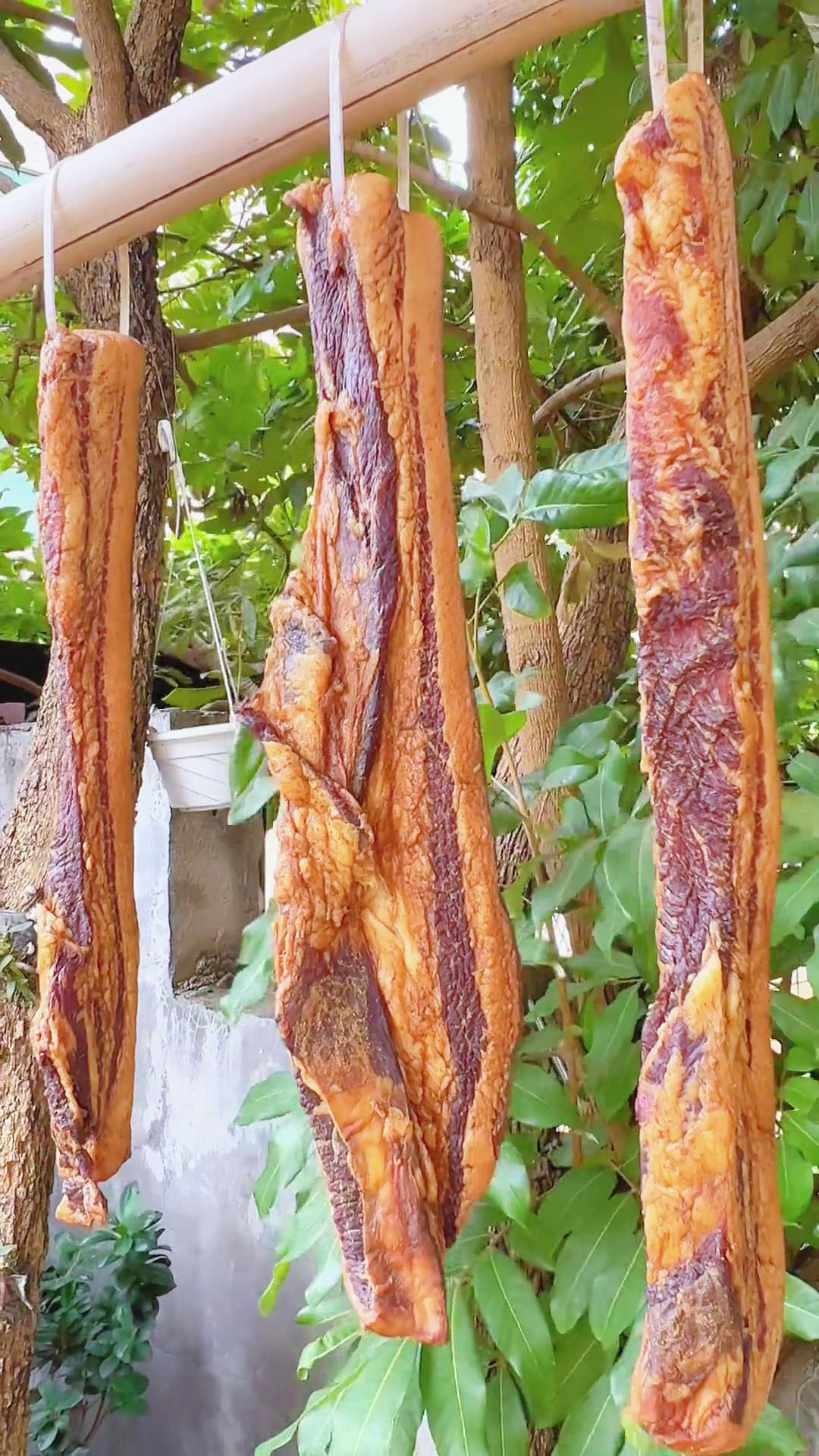
You can hang dry it indoors or outdoors, depending on which works better for you. The pork belly is marinated in salt for a day before marinating again with soy sauce and seasonings.
With Chinese cured pork belly, you can use it as a special ingredient for taro cake, clay pot rice, and lo bak go, to name a few.
In this recipe, I used pork belly rubbed in salt and marinated for a day. Then, I let it dry completely before marinating it again with light soy sauce, Shaoxing wine, and Chinese 13 spices. After marinating, I sprayed baijiu all over the meat and let it hang dry for about 10 days.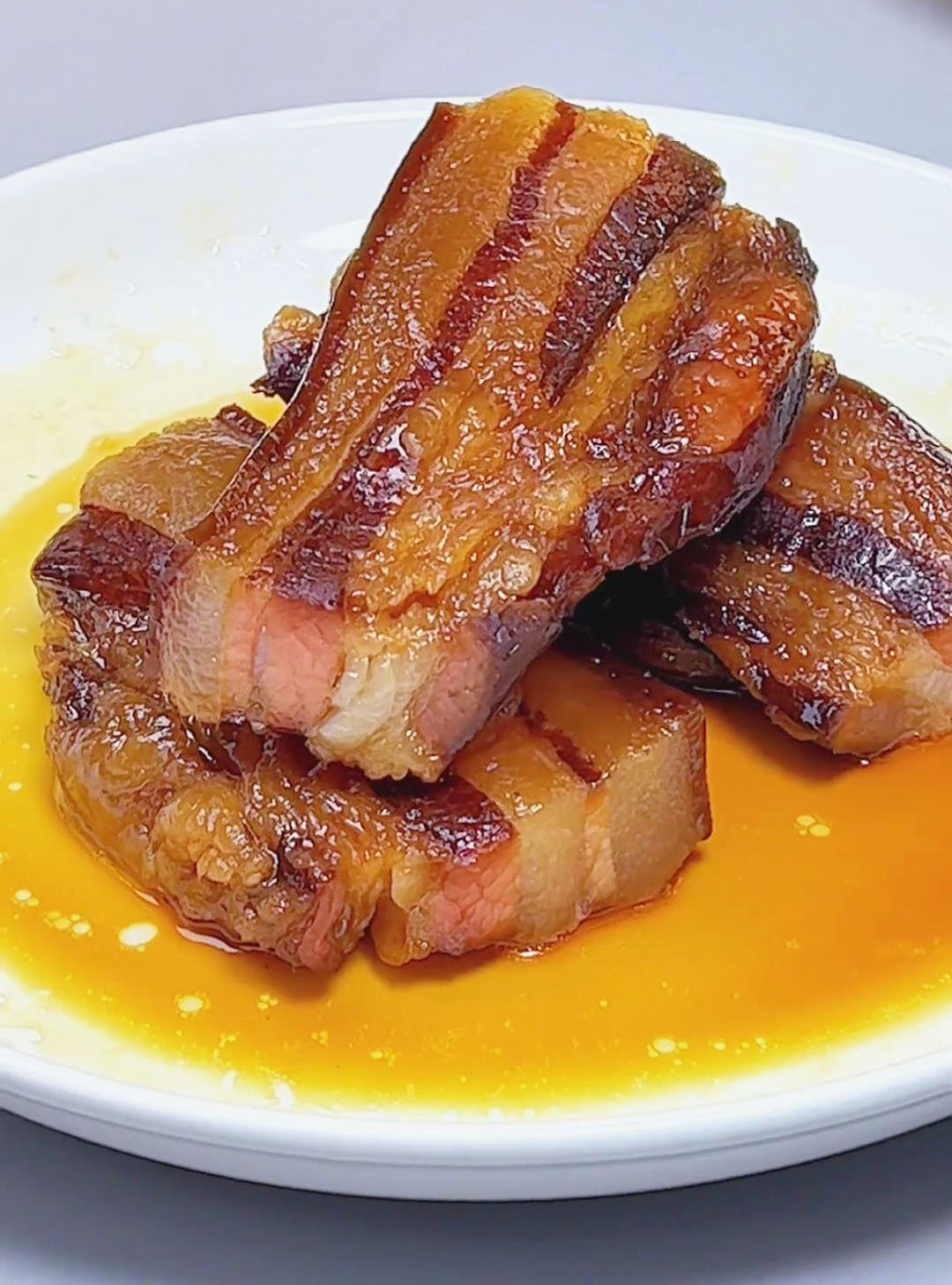
Once you are done, here are some excellent recipes where you can use Chinese cured pork belly:
- Traditional Chinese Egg Fried Rice (蛋炒饭)
- Yang Chow Fried Rice (Yangzhou Fried Rice 扬州炒饭)
- One-Pot Taro Rice (Yam Rice)
- Dim Sum Classic Chinese Turnip Cake (Lo Bak Go)
- Steamed Chinese Taro Cake (Yam Cake)
- Congee Toppings
- Lo Mai Gai
Recipe Tips And Recommendations
I dive deep into expert tips when it comes to marinating, hanging, and curing the meat. Learn more details about how to properly do these steps to create a successful cured pork belly. Don’t skip this section yet, whether you are new to curing meat or not.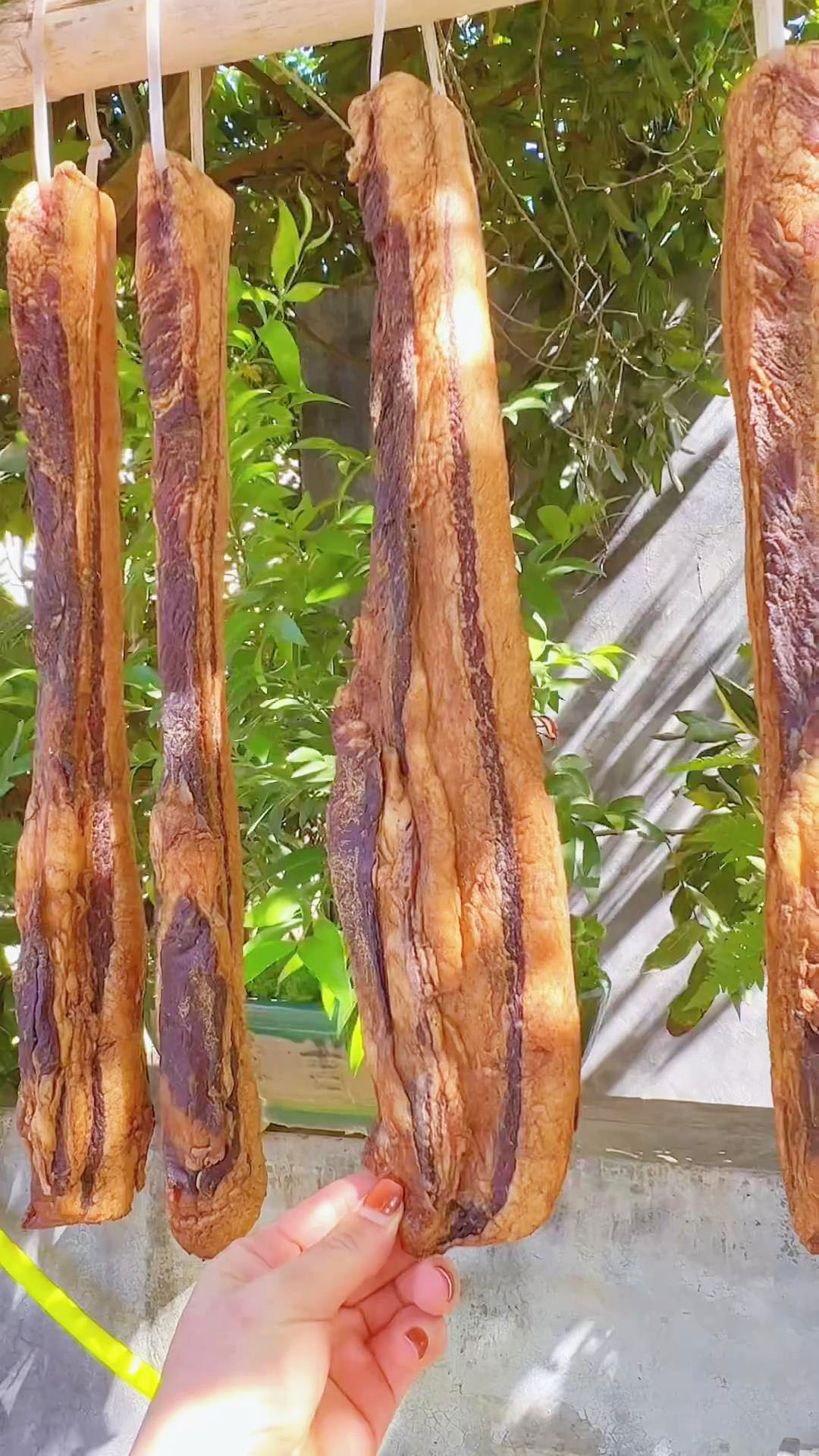
Marinating
- Two marinades: I marinated the pork belly twice, once with salt rub and another with the marinade sauce. For the first marinade, rub salt all over the pork belly and let it marinate for a day. For the second marinade, I submerge the meat in the sauce for at least a day as well.
- Marinate by bowl: When marinating the pork belly, you want to make sure it is well submerged in the marinade. For my technique, I marinated the pork in a large bowl and covered it in plastic wrap. Then, I added extra weight on top using a bowl of water to fully immerse the meat in the marinade.
- Marinate by ziplock bag: Alternatively, you can put the pork belly in a ziplock plastic bag with the marinade inside. If you are using this method, make sure the marinade is spread evenly. You can also flip the pork belly to the other side to evenly spread the marinade.
Hang Drying
- Hanging tools: You can hang dry the marinated pork belly indoors or outdoors using a clothes rack, metal rod, or two chairs with a string or rod. Make sure to leave enough space in between to allow the meat to dry fast and evenly. If the meat is cramped up and sticking together, it won’t dry all the parts of the meat. Think of it as similar to hanging clothes. Our clothes won’t dry up when they are not hung properly. Some parts may still be wet, while some dry.
- Tying tools: If you are using a butcher or cotton string to hang it, I recommend piercing it through the meat and not the fatty parts. Otherwise, the string might only tear through the fat and fall off. It helps if you have a large needle to pierce through the meat to tie the string. Aside from a string, large safety pins and meat hooks also make good tools to hang the pork belly.
- Outdoor method
- Hanging it outside is great for a cool wind and a little bit of sunlight, but not too much. It is recommended to hang it in a shaded area and partly sunny. It is generally okay to let it have sunshine for about 3 hours, but more than that can risk overdrying or spoilage.
- It is best to check the weather report for the week to know if it is the best time to hang the meat outdoors since there is potential rain or snow. If not, you can still hang it inside with a few extra steps.
- Indoor method
- If hanging the meat indoors, it is best to keep the windows open for the air or wind to come in. Remember, allowing enough air ventilation will speed up the drying process. Moreover, it helps avoid a humid environment for the meat.
- It is also possible to hang and cure the meat in a cold room or basement as long as you have a dehumidifier to keep the environment dry. Make sure to have a bucket, newspaper, or plastic to catch the liquid dripping from the meat. Otherwise, it will be a mess that you will have to clean up on the floor.
- Duration
- How long to hang the marinated meat depends on the weather. Some may take 5, 7, or 10 days. Basically, the meat cures faster on dry windy days and slower on humid non-windy days, especially indoors.
Curing
As mentioned, the time to finish the curing process depends on the weather, which can take 5 to 10 days or more to cure the meat.
- The ideal temperature: The ideal temperature should be between 50°F to 55°F. However, it should also not be at freezing temperatures or you risk having frozen pork belly.
- What to do during rain or snow: If it rains or snows, transfer the meat inside to continue drying or store it in the fridge before hanging it again outside.
- Keep watch of animals: Remember, keep watch for animals that may try to eat your meat outside. If you have a pet dog or cat, you may want to keep an eye on them as well.
- The expected results: You will know the meat is almost done curing when the meat looks oily or shiny. Ideally, the outer layer should be fully dried out while the meat remains slightly soft.
- The purpose of baijiu spray: As part of the curing process, the meat is sprayed with baijiu, which helps repel flies and bugs and prevent spoilage.
- Keep everything clean: Another way to prevent spoilage is to make sure everything you use is clean, so make sure to wash your hands and kitchenware thoroughly.
Storing
- Container: To store the finished cured pork belly, wrap it in an airtight container or ziplock bag.
- Duration: Keep it in the freezer for up to 3 months or a few days in the fridge.
- Freeze method: If storing in the freezer, wrap it in parchment paper to prevent it from sticking together and keep it in a freezer bag.
Ingredient Alternatives To Consider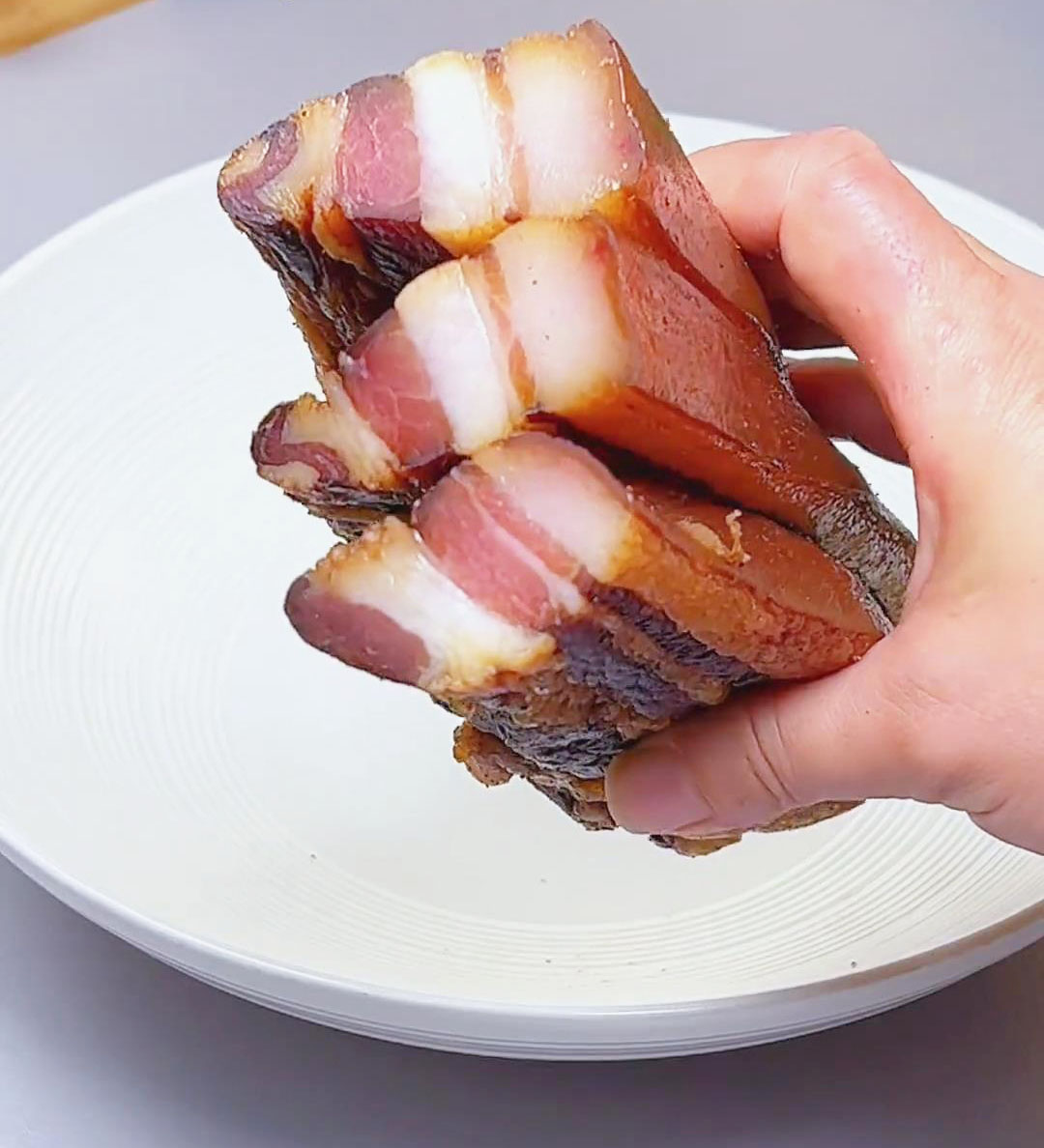
I only used 6 ingredients to make this dish. You can change the ingredients according to your liking. If you wish to look for alternatives, check out my recommendations below.
- Pork belly: I used 11 pounds of pork belly which has half lean meat and half fat. You can use a boneless pork belly with skin or the fat cut off. Aside from pork belly, pork shoulder is an excellent alternative.
- Salt: Salt for rubbing helps draw out moisture from the meat and extends its shelf life. You want the pork belly to dry out, removing as much liquid as possible. It serves as a preservative by dehydration which stops bacterial growth. Use curing salt, Himalayan salt, pink salt, kosher salt, or sea salt. I don’t recommend regular table salt containing iodine since iodine imparts an undesirable taste.
- Light soy sauce: Another ingredient that helps prevent microbial spoilage is light soy sauce. It also imparts an in-depth flavor to the meat with its salty, slightly sweet, and umami taste. Other alternatives to consider are tamari, liquid aminos, coconut aminos, or gluten-free soy sauce.
- Shaoxing wine: Shaoxing wine or Chinese cooking wine acts as a preservative as well. It adds a slightly sweet and briny taste to the pork belly. If you don’t have cooking wine or Shaoxing rice wine, swap it with dry sherry, red wine vinegar, or alcohol-free wine. You can get this in Asian stores or in the international section of grocery stores.
- Chinese thirteen spices: Chinese thirteen or 13 spices mix comes in 45g packs. The most famous brand of this spice is Wang Shou Yi. It has 13 spices in one, including orange peel, cinnamon, cumin, ginger, angelica, Sichuan peppercorn, star anise, nutmeg, galangal, white pepper, cloves, licorice, and cardamom. If you don’t have this, you can replace it with Chinese Five Spice Powder, which is a mix of star anise (八角), Chinese cinnamon (肉桂), fennel seeds (小茴香), Szechuan peppercorns (花椒), and cloves (丁香). Then, simply add the other missing ingredients from the thirteen-spice mix, such as ginger powder, nutmeg, white pepper powder, and cardamom, to name a few. You can find this in Asian grocery stores, in the international section of some grocery stores, or in online markets like Amazon.
- Baijiu (白酒): The meat is sprayed with baijiu, a Chinese alcohol also known as shaojiu, which is the key ingredient I use to make Chinese sausages. It gives the meat an in-depth flavor and aroma and helps repel bugs and flies. Alternatively, you can also use rose wine, rice wine, dry sherry, or whiskey. Since it is going to be used for spraying, you will need to transfer the liquid to a spray bottle.
Checklist Of Kitchenware And Ingredients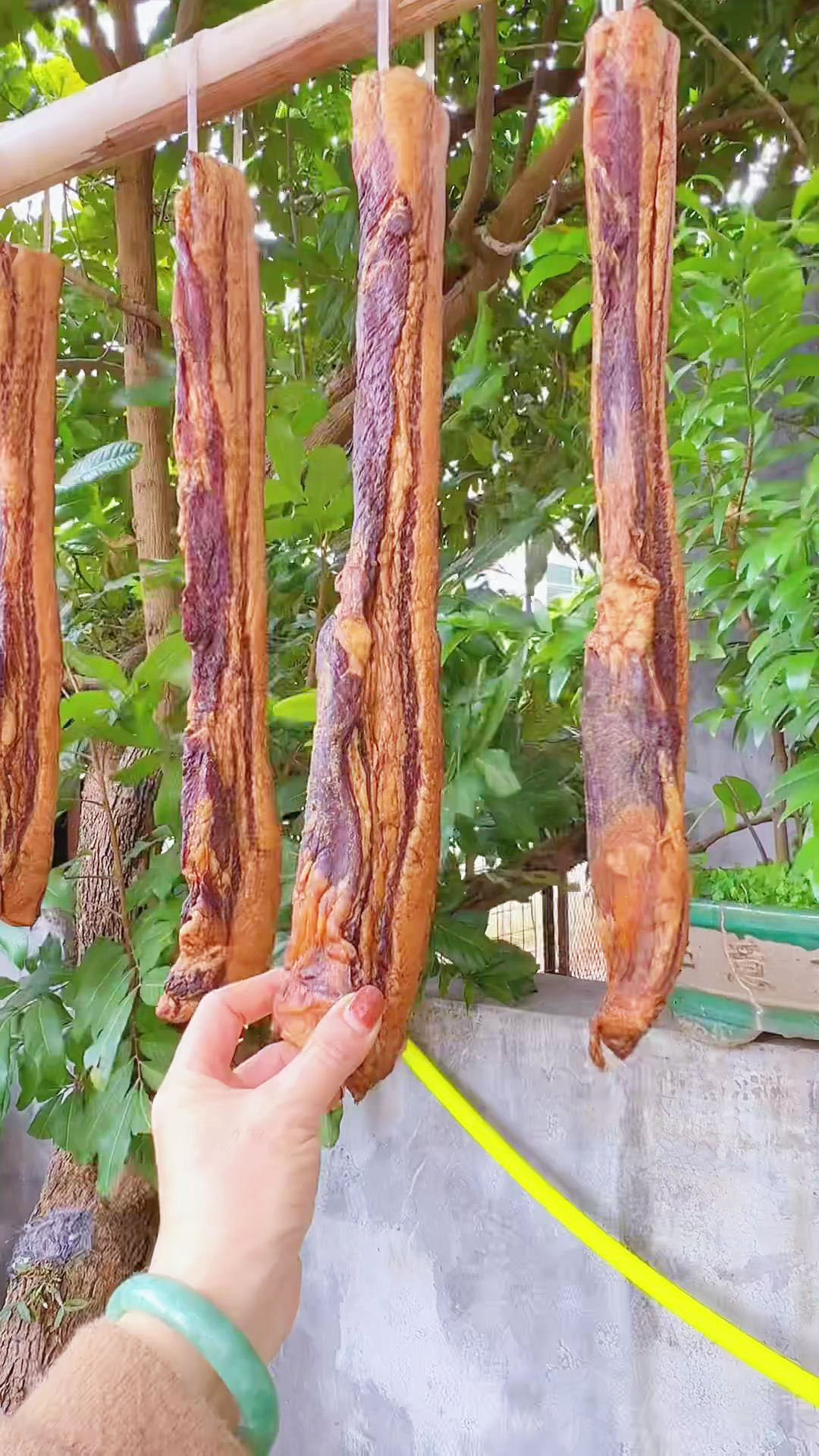
I recommend using a large bowl, basin, or cooking pot to marinate the pork belly since you will need a large amount of the sauce, including 1 liter of soy sauce and half a liter of Shaoxing wine. To tie up the pork belly for hanging, use a butcher’s string, meat hooks, or large safety pins. Prepare your clothes rack or rod to hang the meat and kitchen gloves to protect your hands during the salt rubbing and marinating steps.
Here are the ingredients I used:
- 11 pounds pork belly
- Salt (for marinade), about 50g
- 1L light soy sauce
- 500ml Shaoxing Wine
- A pack of Chinese thirteen spices (45g)
- Baijiu (transferred in a spray bottle for spraying)
10 Steps To Make Chinese Cured Pork Belly
I know it will take days to more than a week to complete this recipe, but the steps are easy and simple. It only involves basic steps, including salt rubbing, marinating, spraying, and hanging. Check out my 50-second tutorial video on Instagram or TikTok to learn more about the steps.
When you are done, chop the cured pork belly and cook it by pan-frying or steaming. Enjoy it on its own with a dipping sauce or as a main ingredient for one-pot rice or congee dishes. Don’t forget to leave a comment and tag @kitchenmisadventures to share your version of cured pork belly.
- Clean the pork belly, pat it dry with kitchen paper, and place it in a large basin.
- Evenly rub salt on each piece of meat.
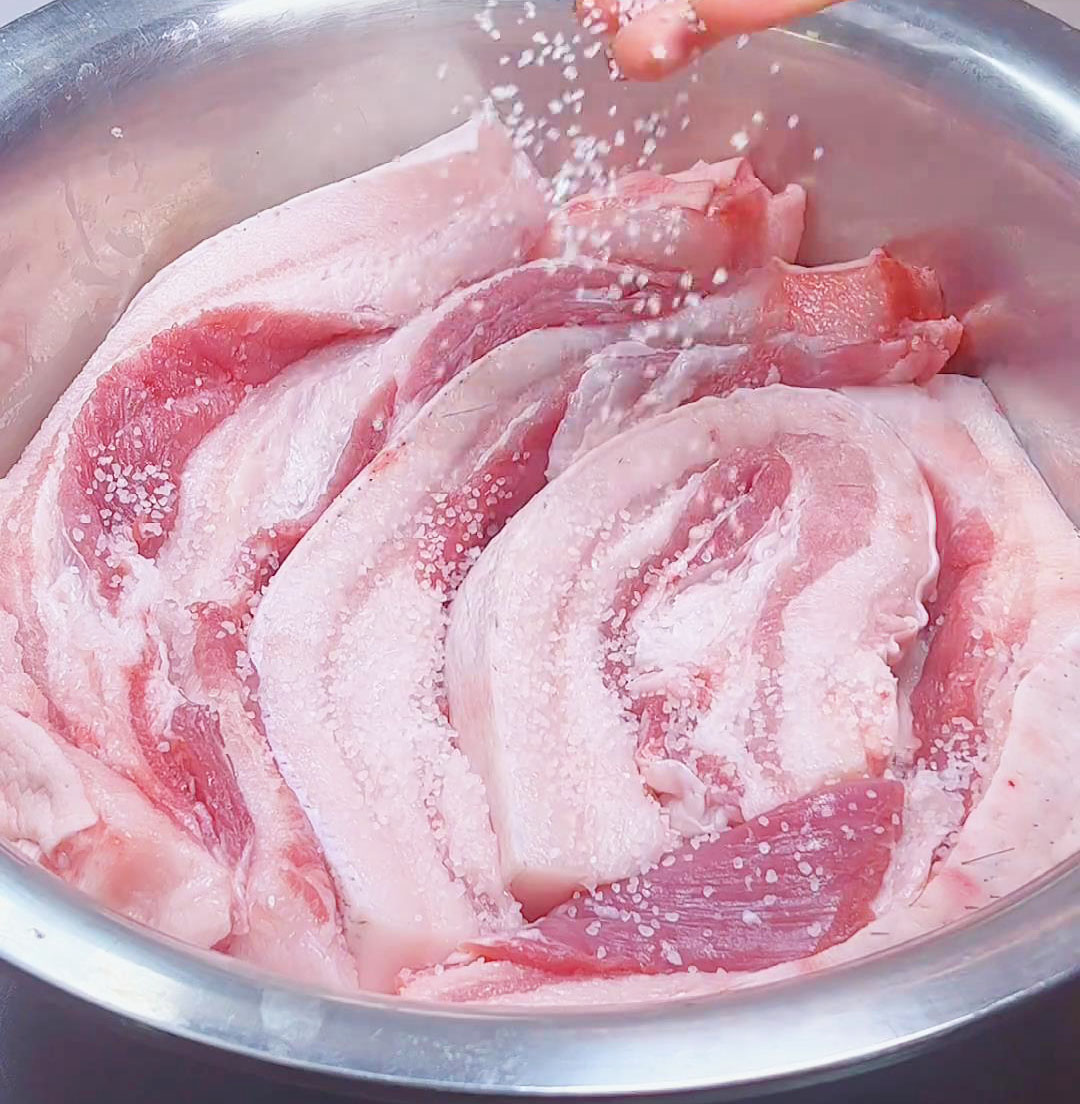
- After applying the salt, cover it with a lid and let it marinate for a day.
- Rinse off the salt with warm water and drain thoroughly.
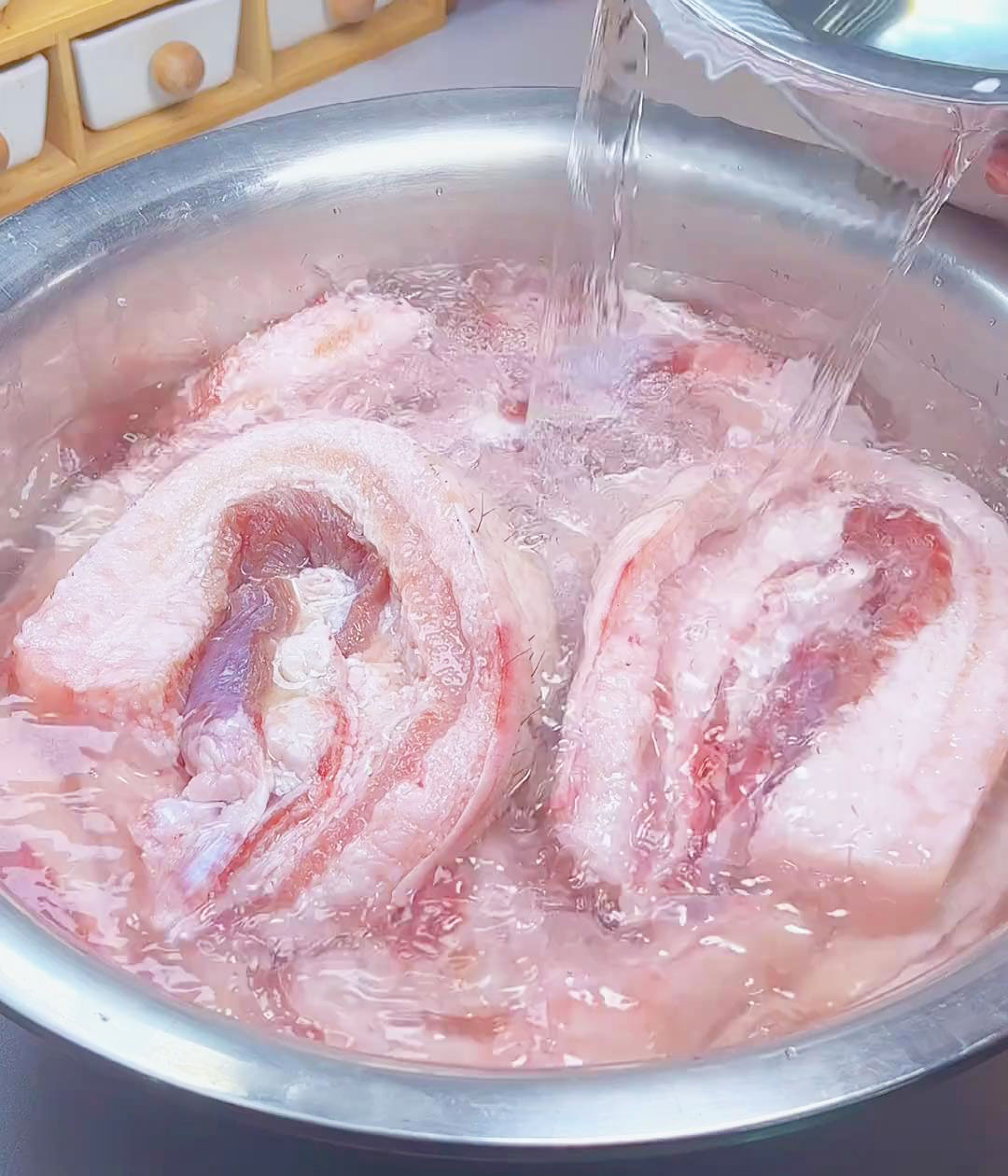
- Tie the meat to the clothes hanger and hang it up. Let the water drain and allow it to dry completely. It is completely dried when there is no water left dripping from the meat.
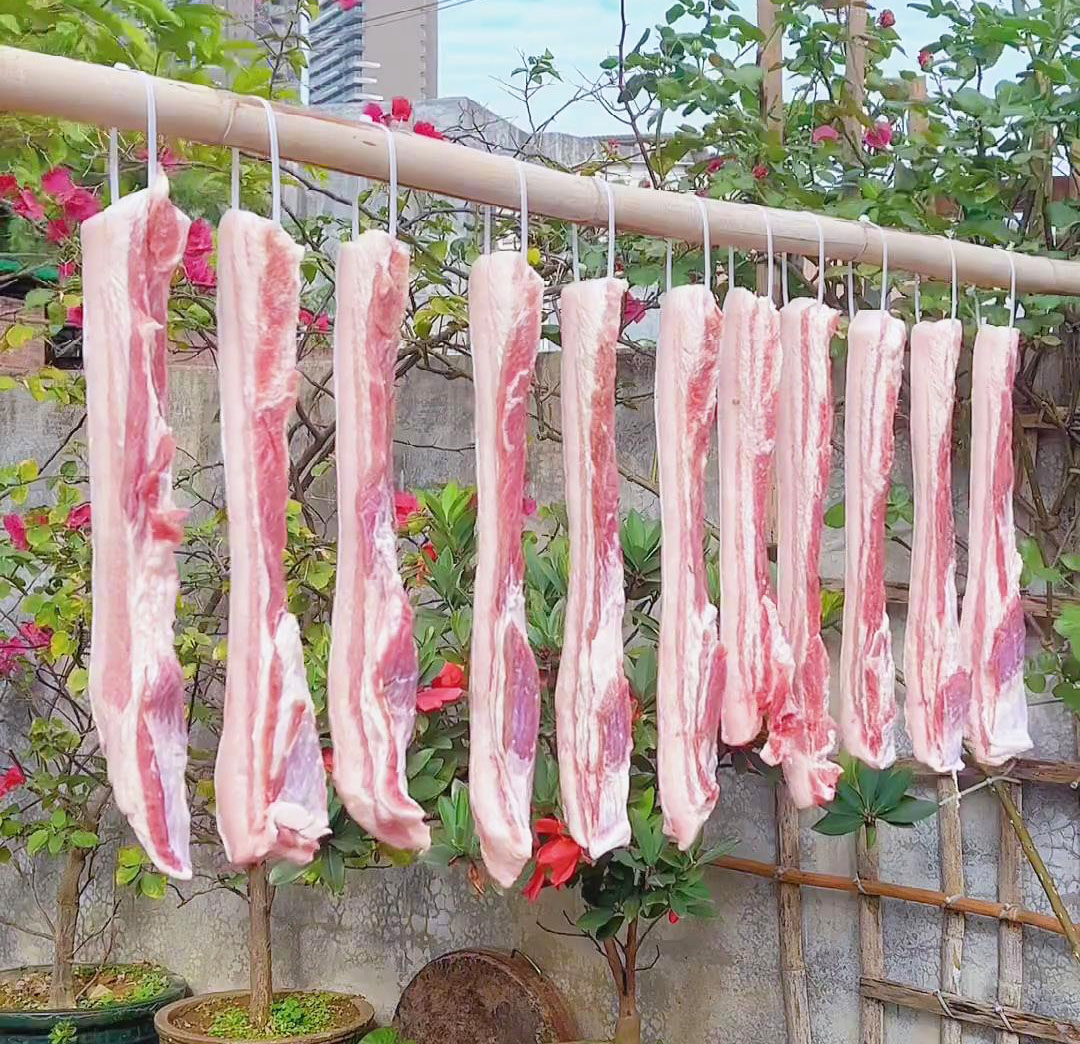
- Transfer the meat back to the large basin.
- In a large bowl, mix light soy sauce, Shaoxing Wine, and a pack of 45g thirteen spices(or substitute with Chinese Five Spice Powder if unavailable). Stir well and pour it into the meat. Ensure that each piece of meat is thoroughly immersed in the sauce.
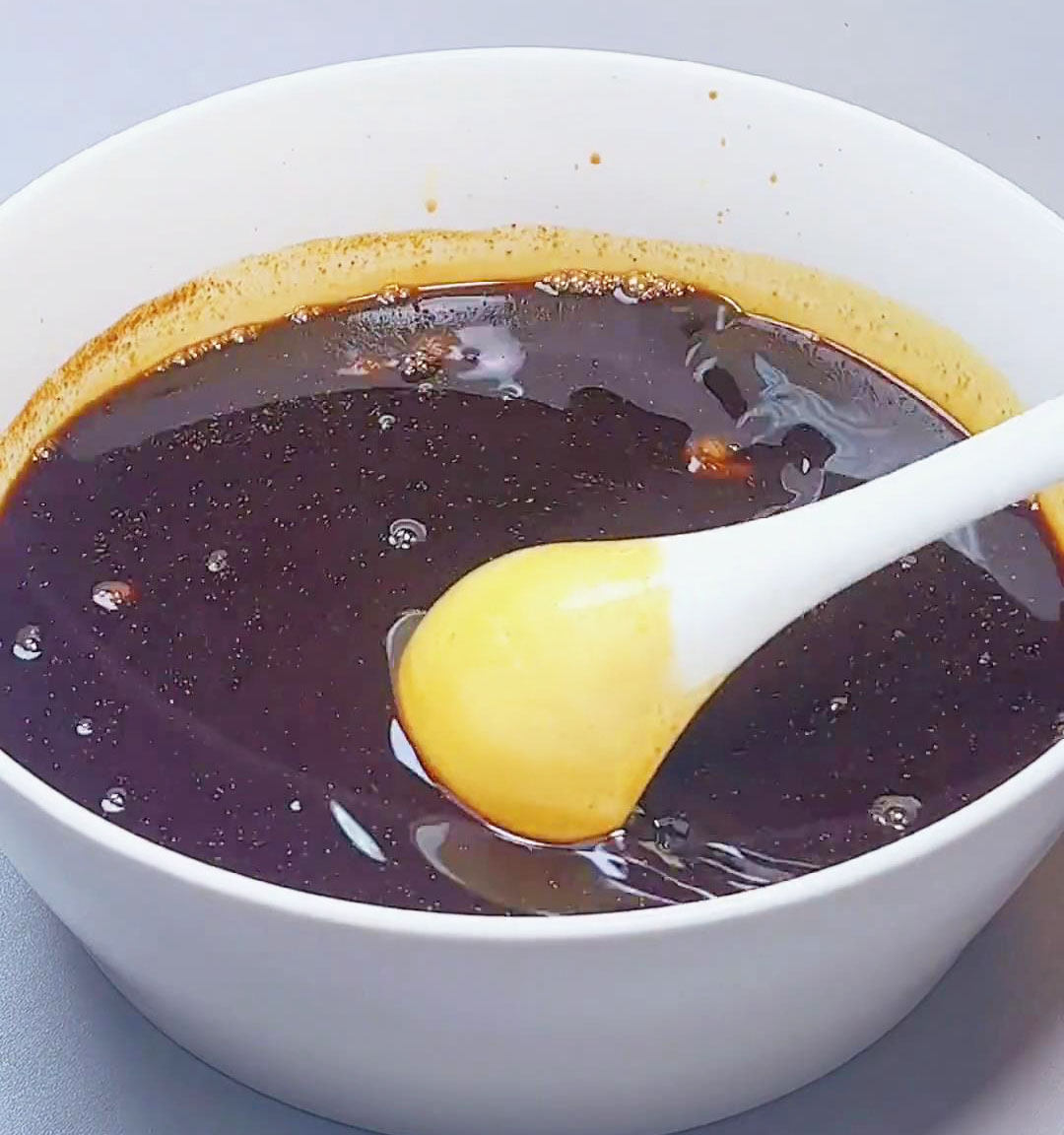
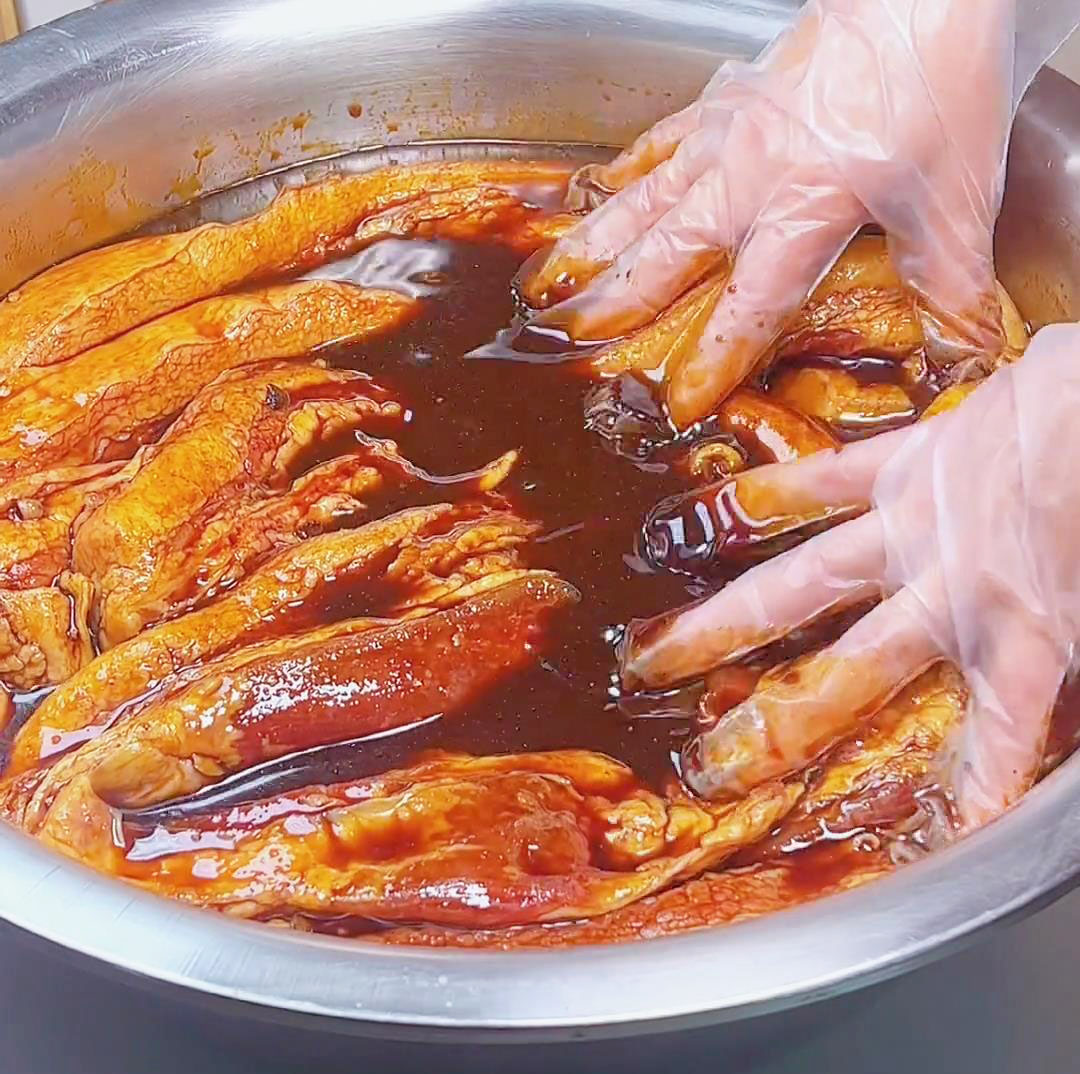
- Cover with plastic wrap. Put a plate on top for balance and place a large bowl of water (or any form of weight) to ensure the meat is fully immersed in the marinade. Let it marinate for a day while it is pushed down into the sauce.
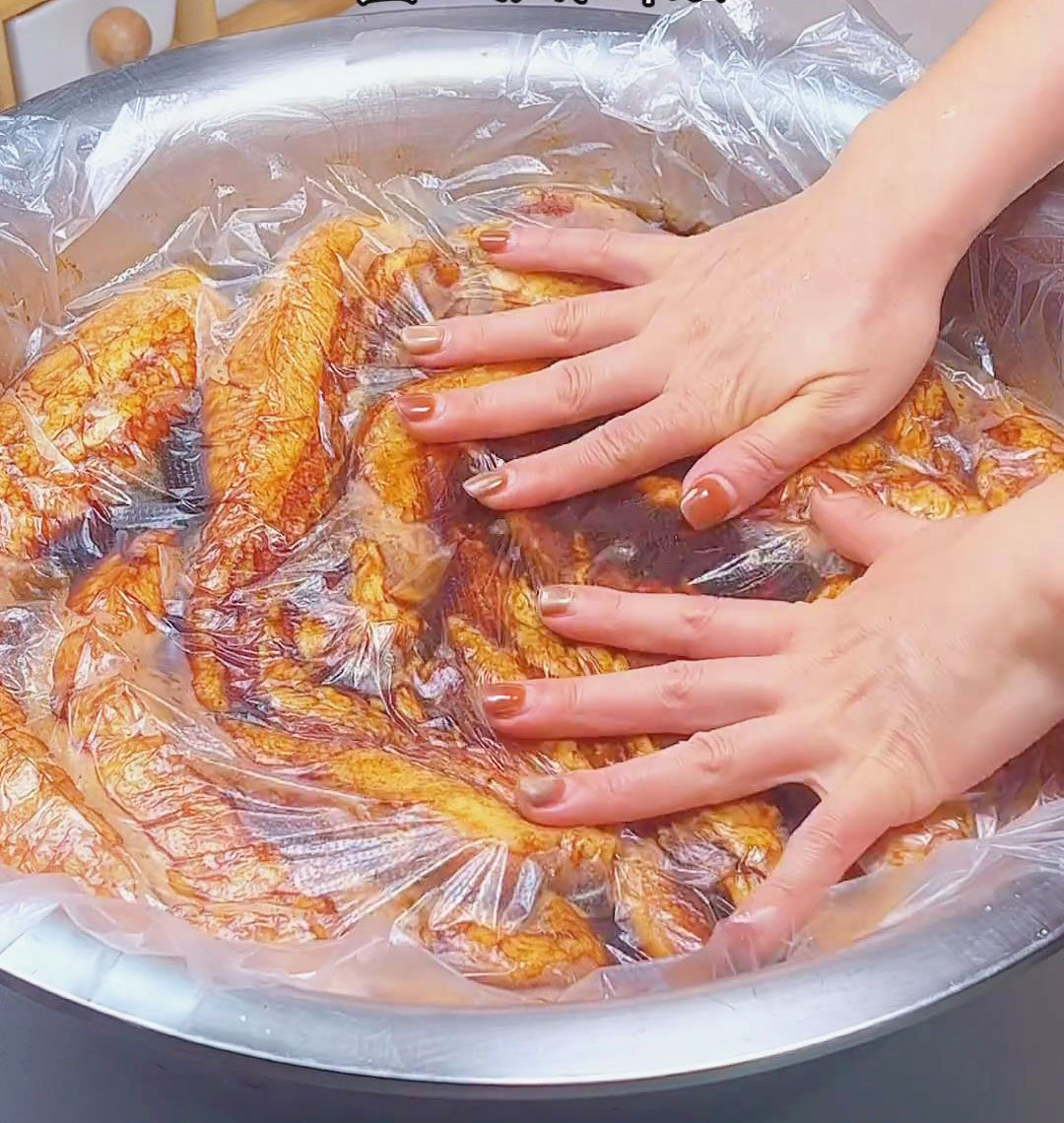
- Hang the meat again to the rod. Spray baijiu all over the meat and let it cure for about 10 days or until the outer layer dries out and the meat is slightly soft.
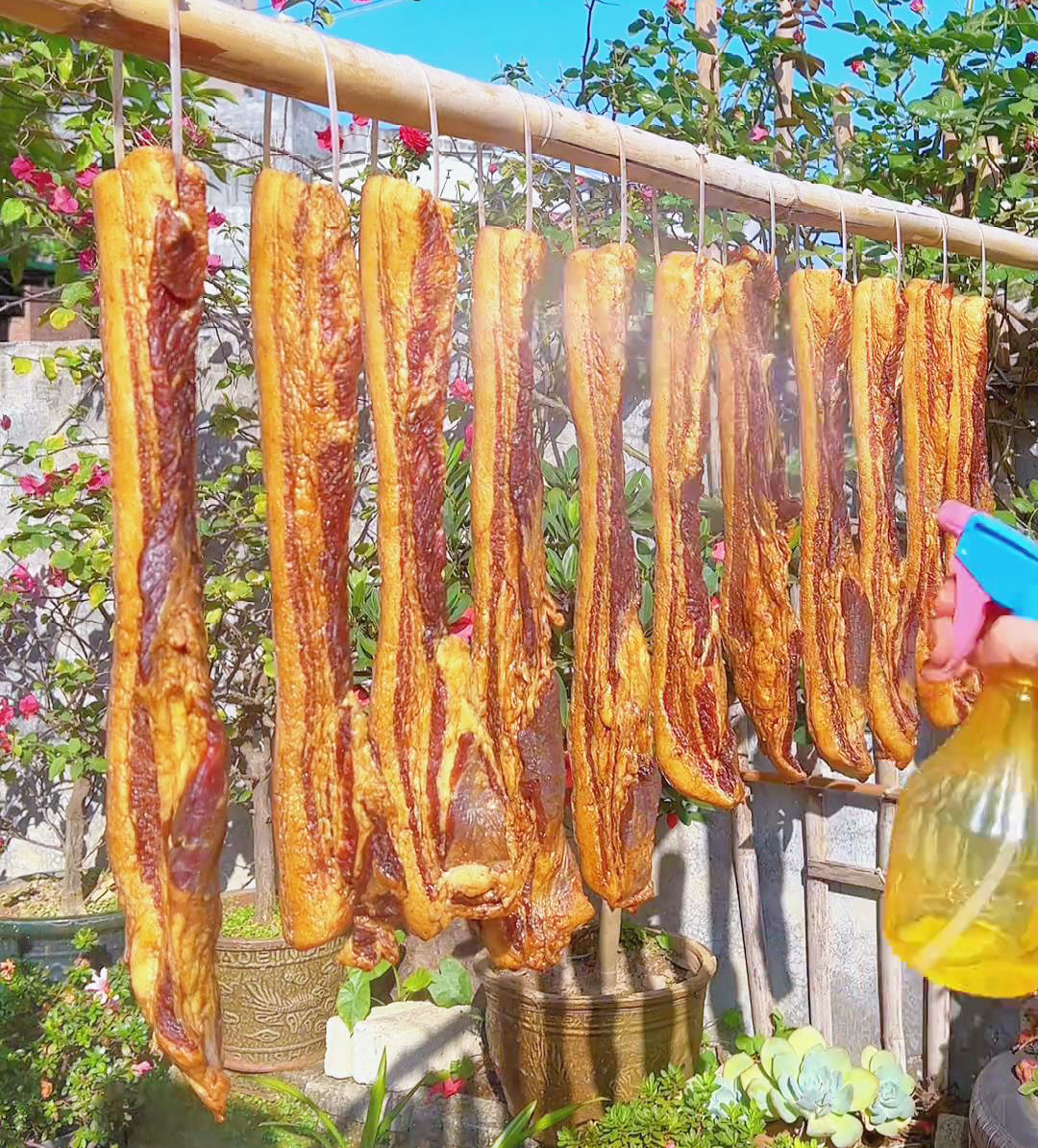
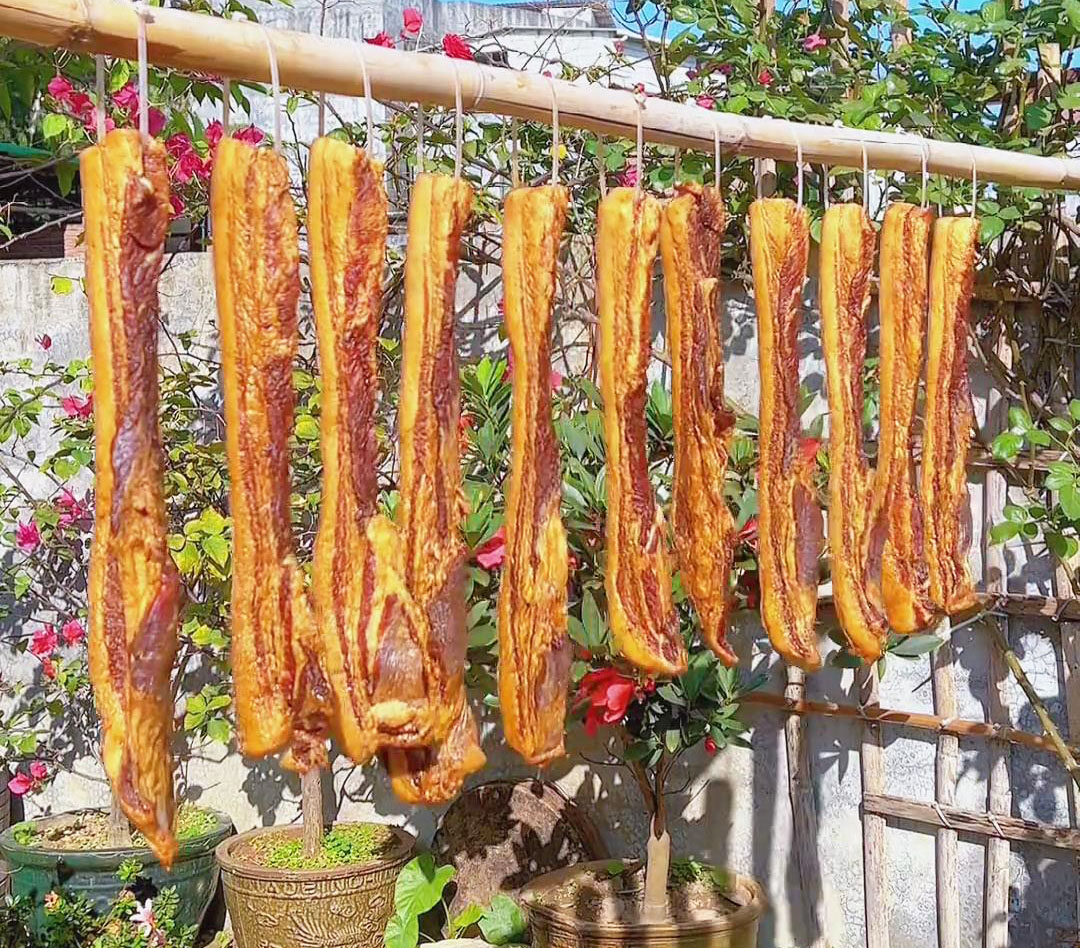
- Enjoy it by slicing it into smaller pieces and cooking it by steaming or pan-frying. Serve it with BBQ sauce, ketchup, sweet soy sauce, or soy sauce with vinegar sauce.
Do you love pork belly recipes? If yes, then you should try making Easy Air-Fried Crispy Pork Belly, Crispy And Juicy Air Fryer Pork Belly, Crispy Pork Belly (Burger), Cantonese Roast Pork Belly, Pork Belly Char Siew, and Kimchi Pork Belly Stir-fry.
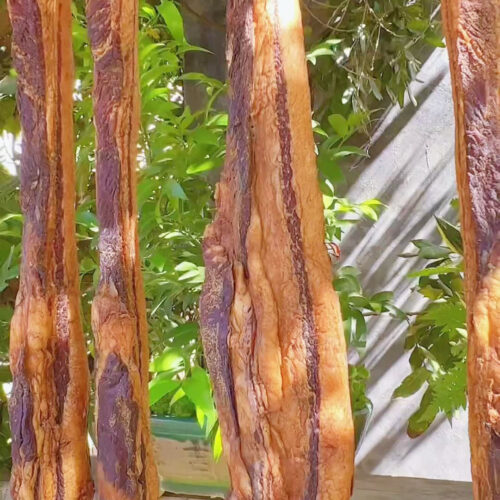
Chinese Style Cured Pork Belly Recipe
Ingredients
- 11 pounds pork belly
- Salt for marinade, about 50g
- 1 L light soy sauce
- 500 ml Shaoxing Wine
- A pack of Chinese thirteen spices 45g
- Baijiu transferred in a spray bottle for spraying
Instructions
- Clean the pork belly, pat it dry with kitchen paper, and place it in a large basin.
- Evenly rub salt on each piece of meat.
- After applying the salt, cover it with a lid and let it marinate for a day.
- Rinse off the salt with warm water and drain thoroughly.
- Tie the meat to the clothes hanger and hang it up. Let the water drain and allow it to dry completely. It is completely dried when there is no water left dripping from the meat.
- Transfer the meat back to the large basin.
- In a large bowl, mix light soy sauce, Shaoxing Wine, and a pack of 45g thirteen spices(or substitute with Chinese Five Spice Powder if unavailable). Stir well and pour it into the meat. Ensure that each piece of meat is thoroughly immersed in the sauce.
- Cover with plastic wrap. Put a plate on top for balance and place a large bowl of water (or any form of weight) to ensure the meat is fully immersed in the marinade. Let it marinate for a day while it is pushed down into the sauce.
- Hang the meat again to the rod. Spray baijiu all over the meat and let it cure for about 10 days or until the outer layer dries out and the meat is slightly soft.
- Enjoy it by slicing it into smaller pieces and cooking it by steaming or pan-frying. Serve it with BBQ sauce, ketchup, sweet soy sauce, or soy sauce with vinegar sauce.

